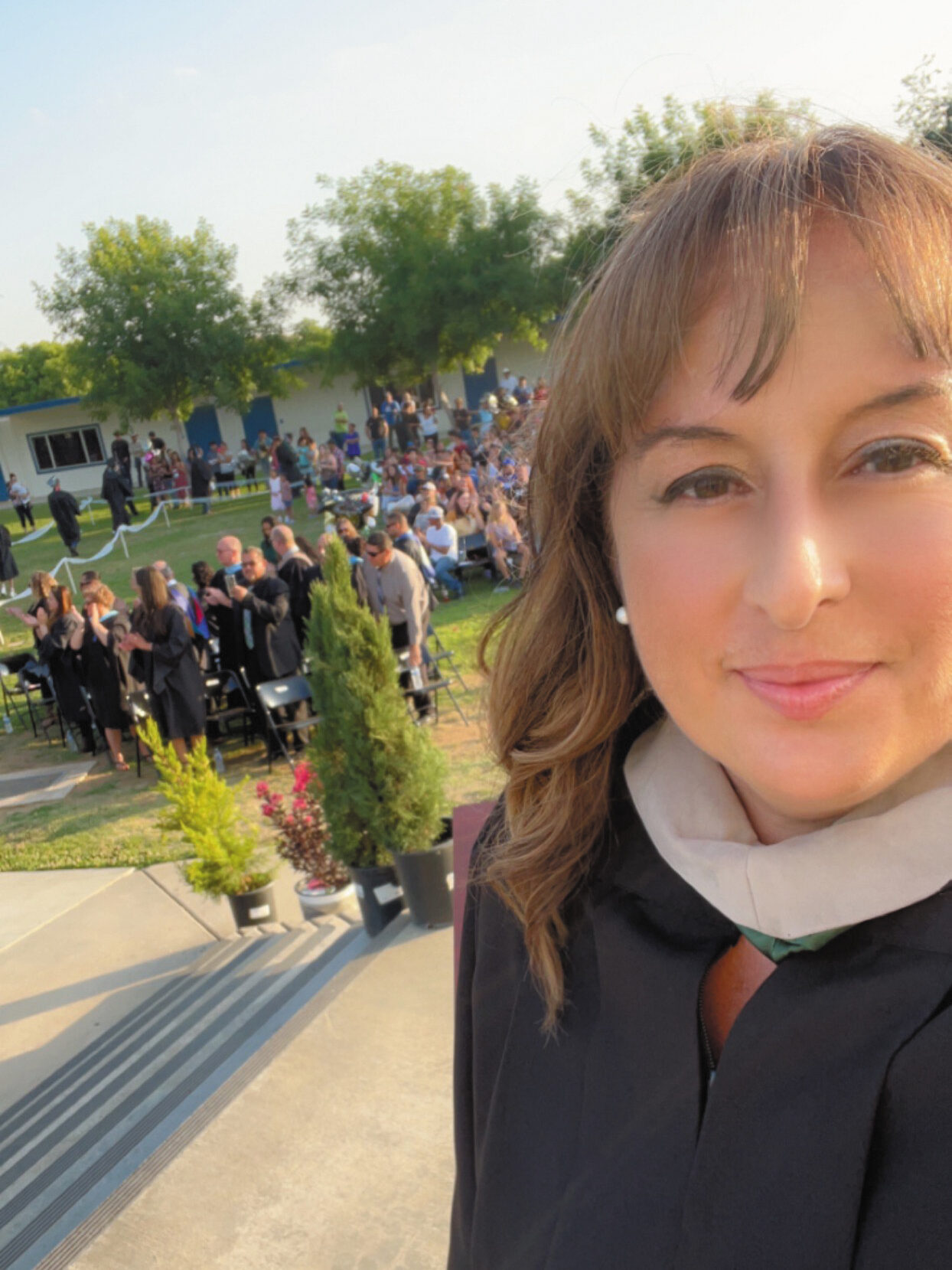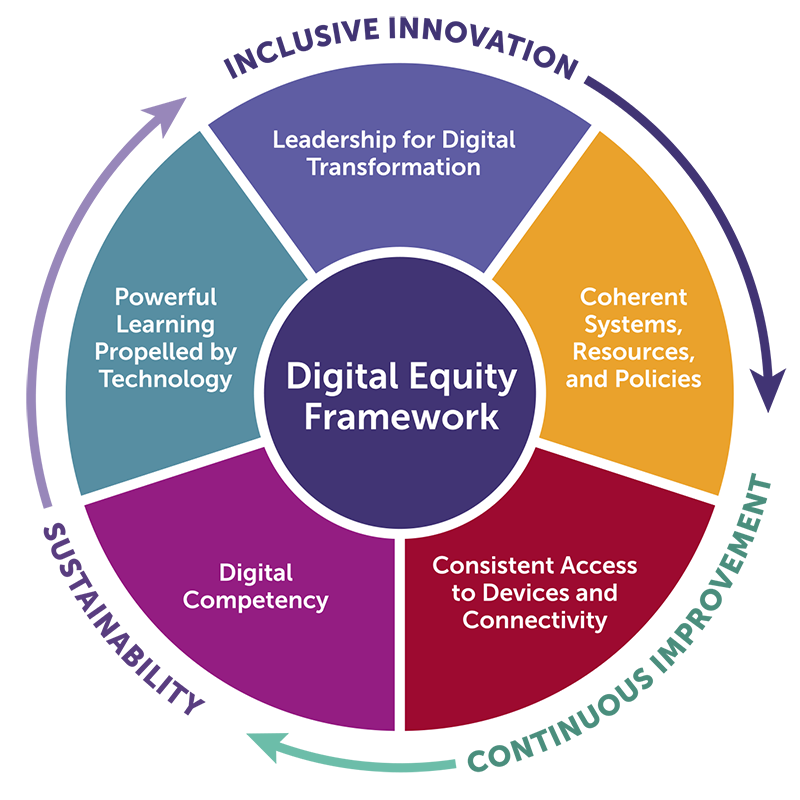Advocacy Agenda: December 2023

Amalia Lopez is known for her direct approach and unwavering commitment to reshaping education. With more than 12 years of dedicated service in Lindsay Unified School District in Lindsay, CA, she has held diverse roles, from English learning facilitator to district director overseeing pivotal projects contributing to the district’s renowned digital and learner-centered transformation. As Principal Lopez, she currently leads four distinct schools that are part of alternative education in Lindsay Unified.
Throughout her career, Lopez has championed the integration of technology in education. When asked about the most significant obstacle she faces in advancing digital equity, her response is unambiguous.
“The problem we have—not just in Lindsay Unified, but across the nation—is that technology has been viewed as an add-on to education. Technology has been the ‘plus one’ of the experience and not a part of the fundamental design of learning. [And in many cases] we’re using technology to replicate the same old pedagogical experiences. The problem is the pedagogy.”
The pedagogical dilemma she highlights became evident during the pandemic, as educators, students, and families grappled with the challenges of remote learning. The deficiency in necessary devices and connectivity was coupled with a lack of familiarity with effective remote learning practices. In contrast, principals like Lopez, in districts that prioritized digital equity like Lindsay Unified, thrived in navigating these challenges.
But what exactly is digital equity? For Lopez, it’s a vision firmly rooted in the dynamic interplay between students, teachers, content, and technology. This vision takes shape through a learning experience that begins with a single compelling question posed to a group of ninth graders: “What are the ecosystems of the world that you don’t know anything about but you wish you did?” This seemingly simple question propels students into a realm of exploration, made possible through their broadband-connected devices. As they delve into the topic, they find a trove of articles, scientific journals, and online videos from across the globe, sparking an enduring fascination with ecology.
However, what sets this learning journey apart is what follows. Guided by their teacher, students are encouraged to identify personal areas of interest within the topic. With minimal structural constraints, they embark on a path of unique research and learning. They actively assess source credibility, validate their theories against the latest scientific advancements, and engage in authentic learning.
This approach not only redefines learning expectations in an alternative education context but also sets a benchmark for how all students should experience learning in any setting. It also reflects Lopez’s dedication to the foundational role digital equity plays in the broader shift toward more learner-centered education models.
At Digital Promise, we view digital equity as a dynamic concept embodied by five key domains:
1. Leadership for Digital Transformation
2. Coherent Systems, Resources, and Policies
3. Consistent Access (Devices & Connectivity)
4. Digital Competency
5. Powerful Learning Propelled by Technology
These domains build upon each other and underscore our steadfast belief in inclusive innovation, continuous improvement, and sustainability.
When taken together, our Digital Equity Framework (shown on Page 19) provides a thoughtful way for system leaders to advance digital equity within a variety of contexts. Here’s how school leaders can use this framework as a foundation for learner-centered education.
Leadership for Digital Transformation
We define Leadership for Digital Transformation by the leadership activities that collaboratively develop and communicate a vision for technology in schools. When enacted, they enable the type of ubiquitous learner-centered education that ensures all students learn at their highest levels and achieve equitable academic, social, and economic outcomes.
Campus administrators play a pivotal role in leading digital transformation by working closely with the school community to craft and communicate a comprehensive vision for integrating technology across all aspects of education, particularly in teaching and learning. This vision extends beyond mere words; it is embraced and embodied by all school leaders and made tangible through its integration into the school’s continuous improvement plan. Campus leaders become champions for learner-centered approaches, identifying opportunities to leverage emerging technologies to enhance teaching, foster collaboration, engage students, and facilitate learning for all.
Coherent Systems, Resources, and Policies
In our experience, the most tech-savvy schools exhibit a remarkable coherence across all school functions by aligning their systems, resources (including time, personnel, and funding), and policies with the school’s technology vision, seamlessly embedded within their continuous improvement plan. Striking examples can be found in schools where technology is intricately woven into core systems such as professional learning communities, instructional design, delivery, coaching models, professional development systems, and assessment and feedback mechanisms.
Campus leaders show commitment to this vision by allocating resources to ensure the sustainability of these systems, which include technology refresh cycles, training and professional development, universally accessible curriculum, and software subscriptions. Moreover, these schools dedicate adequate personnel to support technology integration, including instructional technology coaches and IT managers, as well as release periods for teacher leaders and coaches to participate in and lead professional learning. Strong frameworks, guidelines, and policies operationalize technology usage (such as Technology Integration Matrix), ensuring resources are distributed equitably and managed effectively throughout the institution, covering aspects like device procurement, usage, maintenance, and refresh policies.
Consistent Access to Devices and Connectivity
Access to broadband internet and digital devices represents a significant equity challenge. Schools committed to achieving digital equity take deliberate steps to ensure every teacher and student can access broadband-enabled devices both within and outside the school premises.
Campus leaders develop robust systems for device procurement, distribution, and maintenance, and establish refresh cycles to guarantee all educators and learners have access to up-to-date devices. In situations where broadband access is limited, these schools prioritize digital equity by forging partnerships that provide essential devices and access. They invest in mobile hotspots, advocate for Wi-Fi-enabled buses in underserved communities, collaborate with anchor institutions like libraries and community colleges to extend Wi-Fi access into the community, and assist eligible families in signing up for programs offering low or no-cost internet access, such as the Affordable Connectivity Program.
Digital Competency

While significant progress has been made in equipping schools with high-speed broadband, recent studies highlight a critical gap: Many teachers lack the preparation to harness digital technologies effectively in their teaching. A survey conducted by the National Center for Education Statistics reveals that only 18% of schools strongly agree that teachers “are sufficiently trained in how to use technology” and possess adequate training for its effective integration into teaching.
Educators are not alone in facing this challenge. The National Skills Coalition reports that 13% of all American workers lack any digital skills. This deficit is even more pronounced among people of color, with half of Black and 57% of Latino workers having limited or no digital skills. Alarmingly, one-fourth of all American job-holders lacking digital skills are between the ages of 16 and 34.
At Digital Promise, we firmly believe that K–12 schools hold the key to achieving digital equity, and building the digital competency of educators and students is a crucial step. We define digital competency as the digital skills, mindsets, dispositions, and behaviors required for the effective use of technology in teaching, learning, and life in our increasingly digital society. Schools making headway in the journey toward digital equity have adopted technology standards and seamlessly integrated digital competency development within their professional learning systems. In these schools, instructional coaches play a pivotal role, possessing expertise in technology’s effective use, pedagogy, and the ability to lead adult learning. These instructional coaches are strategically deployed to enhance educator capacity through cycles of learning, one-on-one observations, feedback, and modeling. Within this context, students are provided ample opportunities to acquire and apply digital skills within all course offerings, in extracurricular programs, and through participation in student tech teams, for example.
Powerful Learning Propelled by Technology
The progress schools make toward achieving digital equity becomes evident in the classroom (or during remote learning) through the frequency and duration of students engaging in powerful learning experiences. We define this aspect of the framework by the intersection of learner-centered pedagogy and the meaningful incorporation of emerging technologies and digital tools. This integration results in rigorous, relevant, and deep learning experiences for students.
In the classroom, powerful learning propelled by technology results in student uses of technology that simultaneously support the development of content knowledge in the subject areas along with a host of other transferable skills needed for success in an increasingly technological future. When students assume increased agency over aspects of their learning that situate content development within authentic tasks, they experience greater motivation and practice applied problem solving, communication, and collaboration. When mediated through technology, the learning process provides scaffolds that are responsive to individual learners’ needs, while also enabling students to practice transferable skills like digital literacy needed to make sense of curated resources, digital creation in finding and selecting the right tools to represent information, and digital citizenship in negotiating the appropriate methods to disseminate ideas, for example.
Like Principal Lopez and the thousands of school and district leaders we’ve learned from over the last decade, our vision is clear: We aspire to ensure all schools, teachers, and students enjoy consistent and sustained access to powerful learning that puts learners on a path toward economic security, agency, and well-being. By addressing each facet of our Digital Equity Framework, we believe school leaders can establish a foundation capable of not only transforming current teaching practices and learning experiences but also future-proofing their schools for the ever-evolving technological landscape.
Jeffrey Starr, EdD, leads the Learning Design & Delivery department on the Digital Equity team at Digital Promise, where Jessica K. Jackson, MBA, is the deputy director of research, evaluation, and design, and D’Andre Weaver, PhD, is chief digital equity officer. Learn more at digitalpromise.org.
References
Education Superhighway. (2023). Journey to 99%.
educationsuperhighway.org/our-story/journey-to-99/
Misha, A. (2023, August 21). Empowering students to support their school communities through student tech teams. EdSurge. edsurge.com/news/2023-08-21-empowering-students-to-support-their-school-communities-through-student-tech-teams
National Institute of Education Sciences. (2021, November). Use of educational technology for instruction in public schools 2019-20. nces.ed.gov/pubs2021/2021017Summary.pdf
National Skills Coalition. (2020, May). The new landscape of digital literacy: How workers’ uneven digital skills affect economic mobility and business competitiveness, and what policymakers can do about it. nationalskillscoalition.org/wp-content/uploads/2020/12/05-20-2020-NSC-New-Landscape-of-Digital-Literacy.pdf
National Skills Coalition. (2020, March 20). Applying a racial equity lens to digital literacy. nationalskillscoalition.org/wp-content/uploads/2020/12/Digital-Skills-Racial-Equity-Final.pdf
